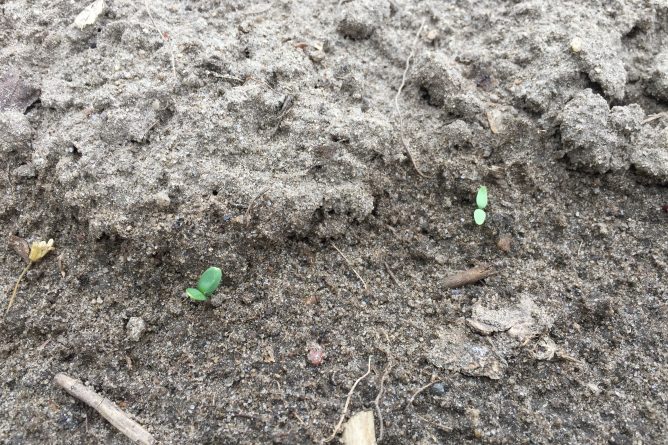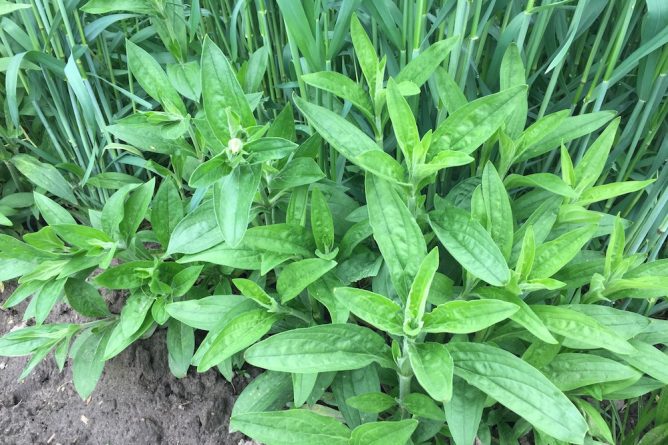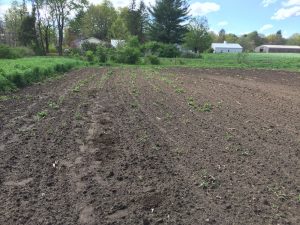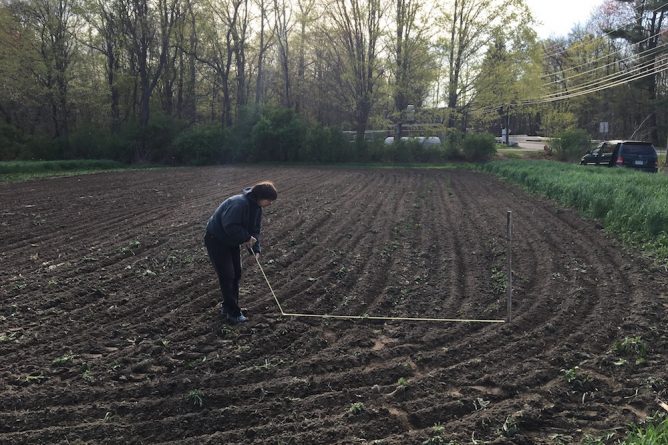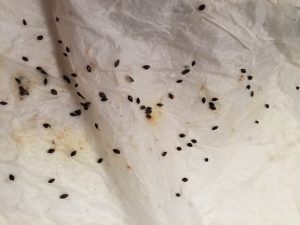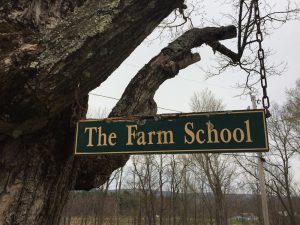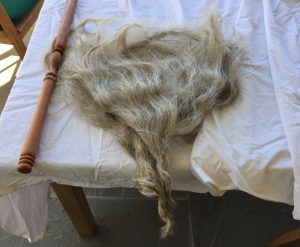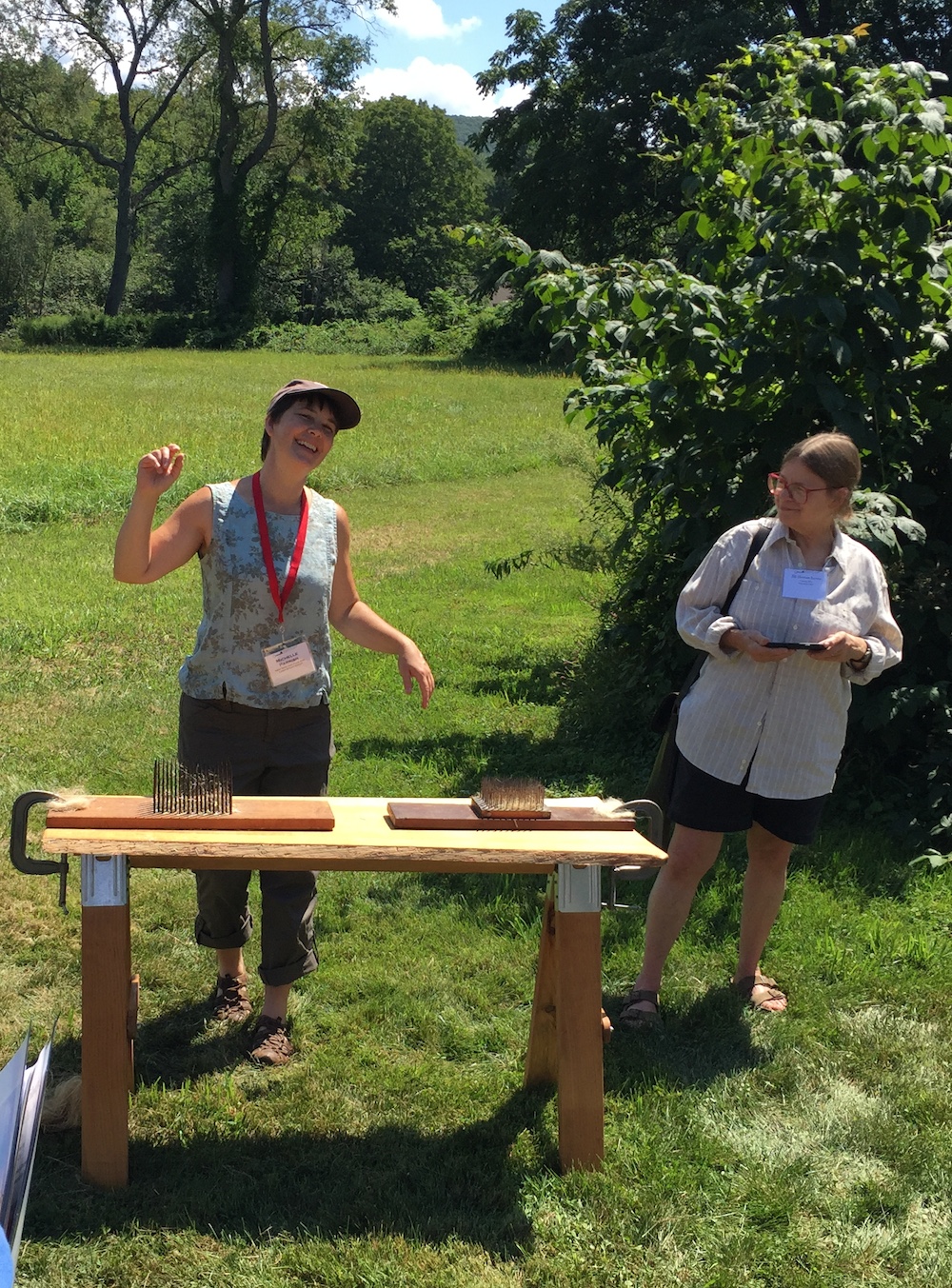While I weeded the flax plot on May 6th, I was simultaneously glad for the opportunity to dig out the campion, and worried about weed pressure later in the summer, and worried that nothing had come up yet. So, I decided to spread another ten pounds of seed. There were a few reasons for this. First, I was worried that I hadn’t accounted enough for the possibility that I’d get a really low germination rate. Second, the more densely the flax is planted, the less the stalks ought to branch as they grow. Third, the more crowded the plants are, the finer the stalks will be and theoretically the finer the fiber will be. Fourth, a dense stand of flax might, hopefully, crowd out weeds. Continue reading “Ten More Pounds of Electra”
Weeding Out Campion
On May 6th, after the rain stopped, I stopped by the flax plot to see how things were going. There were no flax seedlings, but there was a lot of some other plant that I didn’t recognize.
They were big, robust, and had very deep and spreading roots. Since the flax hadn’t emerged yet, I decided to seize the opportunity to weed out as much of these deep-rooted plants as I could. So, I got a pitchfork and began digging. Continue reading “Weeding Out Campion”
Planting Electra
On Sunday April 30th I planted this year’s flax crop. Thanks to the generosity and support of Bernard Brennan at Amethyst Farm and Jeffrey Silberman in the Textile Development and Marketing Department at Fashion Institute of Technology, I am going big this year. Well, big for me. Up until now I have never grown much more than 225 square feet in a given season. This year I have planted approximately 1500 square feet! Continue reading “Planting Electra”
Japanese Indigo Seedlings
Back on April 16th, I set up a germination experiment with about 300 Japanese indigo seeds from 2014. I put them between layers of wet paper towels inside a zip-lock bag and placed them on top of the hot water heater. It took a really long time for any of them them to sprout. Here’s what they looked like on April 24th:
Farm School Dye Day
One of the fun things I got to do last week was to visit the Farm School in Athol, MA, and to lead a natural dyeing workshop for the participants in their adult farming program. The Farm School combines two of my favorite things: agriculture and education. I had never visited their farm before, so I was thrilled to have the opportunity to be there and to get a better understanding of their different programs. I was greeted by this cheery sign when I first arrived:
Spinning Flax
Last week was April vacation, which meant I had more free time than usual to do fun things. Last Tuesday I was thrilled to spend about four hours with Lisa Bertoldi getting some instruction in spinning flax. You might think, with all the flaxy things I do, that I would already be good at spinning flax. Not yet. It has been a goal for me for many years, but recently it has made it to the top of my “urgent” list. Urgency plus vacation days equals actually devoting time to it! Thanks to Lisa, I am quite a bit better at spinning flax now. (12/30/2023 Edited: Lisa no longer has a website but you can read more about her on the Working Weavers Studio Trail website)
Here is the strick of flax spread out on the table. I am getting the fiber ready to dress the distaff. You can see the distaff on the left:
Fiber Fiber Everywhere
When I’m describing the steps involved in extracting fiber from a fiber-plant such as flax, people often ask, “How on earth did anyone ever figure that out?” I have thought about this question a lot. I have many ideas about it. Some can be backed up with references and citations, and some are just hunches based on my personal experience.
I believe that we humans come from a long line of brilliant thinkers and observers, experimenters and creators. The human use of flax fibers in Europe dates to at least 34,000 years ago. Humans and our human-like relatives and ancestors have been really smart and really creative for tens if not hundreds of thousands of years. Furthermore, primates in general are really smart, so I am happily willing to accept any kind of habitat-modifying, tool-using, culture-teaching behaviors dating back 2 or 3 million years, at least. Which is all very deep. It is admittedly hard to have a clear mental picture of what life might have felt like for a hominid so long ago. Continue reading “Fiber Fiber Everywhere”
Testing Japanese Indigo Seed
In 2014 I was very excited to acquire my first Japanese indigo seedlings at the Massachusetts Sheep and Woolcraft Fair in Cummington, MA. I bought them from Blue By Ewe in Temple, New Hampshire. That year I saved the whole crop for seed. You can read about my harvest in an earlier blog post here. I intended to expand the amount I grew each year and save my own seed annually.
I did manage to grow my own seedlings in 2015, which I documented in a couple posts that you can link to here and here. I even managed to use the plants for dyeing that year. However, I was not on the ball to save seed in an organized way that fall, and I did not grow any Japanese indigo in 2016. Continue reading “Testing Japanese Indigo Seed”
Last Session on Saturday Afternoon
Once the morning sessions at the Flax and Linen Symposium were over, and had obviously been successful, I moved into the afternoon mode. I have already posted photos of the demo session in the afternoon. I didn’t post this photo at first because it seemed too frivolous. However, I decided to include it because you can obviously see that I am happy. Goofy and happy. As nervous as I was and as much as my legs were shaking, it was fun. So, here’s a photo of me having fun amidst the anxiety:
Later on Saturday Morning at the Flax and Linen Symposium
The rest of the morning was about retting and flax processing. Again, it’s hard to take photos in the dark, and it’s hard to summarize. The first speaker about retting was Cassie Dickson (John C. Campbell Folk School) with her amazing examples of the different colors that different retting conditions can produce. Continue reading “Later on Saturday Morning at the Flax and Linen Symposium”

